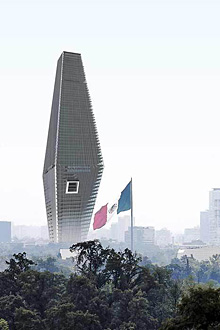 |
 |
 |
 Editorials | Issues | November 2007 Editorials | Issues | November 2007  
Mexico's Centennial/Bicentenial Just Three Years Away
 Allan Wall - PVNN Allan Wall - PVNN


| | Mexico's proposed Bicentennial Tower, at a height of 984 feet, would be the tallest skyscraper in Latin America. |
By some strange twists of fate, some of the dates in Mexican history display some interesting coincidences.

For example, Hernan Cortes and his Indian allies defeated the Aztecs in 1521, laying the foundation for modern Mexico. Three centuries later, in 1821, Mexico became independent from Spain.

Nowadays though, the actual 1821 independence anniversary is not remembered much. The 1810 anniversary, which was really the beginning of what later became the independence movement, is what is celebrated, on September 15th/16th of each year.

And that leads us to another notable coincidence, that of 1810 and 1910. The movement that became the Mexican Independence movement began in 1810. The Mexican Revolution began in 1910 (on November 20th, the day it is still celebrated.) That means that, just 3 years from now, in 2010, Mexico is slated to commemorate, in the same year, the centennial of the Revolution and the Bicentennial of the Independence movement (or what became the independence movement.)

In Mexico City there is a large arched structure known as the Monument to the Revolution. Ironically, this was constructed on the eve of the Revolution by dictator Porfirio Diaz, as a monument to Mexico's independence. But Porfirio abdicated and left the country, and the structure was dubbed a monument to the Revolution.

The Mexican Revolution lasted from 1910 to 1920, more or less. (There is disagreement as to when it actually ended.) Even today there is a lack of unanimity over its legacy.

The long-ruling PRI glorified the Mexican Revolution. That's because the faction that eventually won the Revolution organized itself into a political party that eventually became known as the Institutional Revolutionary Party.

In fact, the party's very name, the strange juxtaposition of "institutional" and "revolutionary" implied that PRI leaders were the ideological heirs of the Mexican Revolution, continuing to bestow its benefits to the Mexican people.

But the PRI no longer runs Mexico. In recent years, some Mexicans have criticized the Revolution for not being all it was cracked up to be. It's been belittled from the right end of the political spectrum, and on the left end (for not having gone far enough.)

In 2006, shortly before completing his presidential term, President Fox canceled the annual Mexican Revolution parade, on the grounds that it was an obsolete celebration which people didn't want to participate anymore. (However, another reason he canceled it was that on the same day AMLO (Andres Manuel Lopez Obrador) was having himself sworn as the "legitimate" president of Mexico in the Zocalo plaza.)

Some have gone so far as to repudiate the Mexican Revolution altogether, including noted Mexican pundit Sergio Sarmiento who calls the Revolution a "monumental failure."

It appears the legacy of the Mexican Revolution will continue to be debated and re-interpreted. How will future generations view the Revolution in the context of Mexico's historic national identity?

And what lessons should be drawn from it? A nation and its people need shared historical experiences, what Abraham Lincoln called "the mystic chords of memory" to bind them together. Annual commemorations help to affirm a nation's historical identity.

Yet as time goes by, a nation's history is re-examined and the changes in emphasis may ensue. In the United States, too, there are disputes over our own history and its significance.

Still, there's nothing like a big celebration. And a dual Independence Bicentennial and Revolution Centennial should definitely qualify as a big celebration.

Not only that, but a tower has been proposed for construction in Mexico City by 2010. It's called the Torre Bicentenario (Bicentennial Tower.) At a height of 984 feet (300 meters) it would be the tallest skyscraper in Latin America. It would have 70 floors, and its estimated cost would be $600 million. (Yet don't such projects always cost more than the estimates?)

The Torre Bicentenario would be located at the edge of Chapultepec Park, with its famous hilltop castle, forest and complex of museums.

The proposal is controversial, involving questions of traffic flow, property, the existing building on the proposed location, and of course, politics.

The Mexican federal government is against it, the Mexico City government is for it.

But even if the tower is constructed, it would be surpassed in height in 2011 by another proposed skyscraper, this one in Panama, which would stand at 346 meters, beating the Mexico City tower by 46 meters.

Well, it's something to think about.
 Allan Wall is an American citizen who has been teaching English in Mexico since 1991, and writing articles about various aspects of Mexico and Mexican society for the past decade. Some of these articles are about Mexico's political scene, history and culture, tourism, and Mexican emigration as viewed from south of the border, which you can read on his website at AllanWall.net. Allan Wall is an American citizen who has been teaching English in Mexico since 1991, and writing articles about various aspects of Mexico and Mexican society for the past decade. Some of these articles are about Mexico's political scene, history and culture, tourism, and Mexican emigration as viewed from south of the border, which you can read on his website at AllanWall.net.

Click HERE for more articles by Allan Wall. | 
 | |
 |



